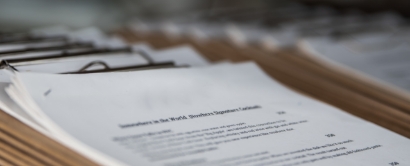May 23, 2025 | UCLG ASPAC engaged representatives from local governments, technical experts, and members of working groups from the 10 CRIC pilot cities to visit and learn from Banyumas’ community-driven and integrated waste management system, which serves as a model for decentralised climate action. Banyumas has made significant strides in solid waste management, in which the system encompasses waste collection at the community level and the conversion of plastic waste into valuable products such as Refuse-Derived Fuel (RDF), paving blocks, and roof tiles.
The activity was conducted as part of the Climate Resilience and Innovation Forum (CRIF) 2025. The visit provided CRIC pilot cities with a concrete example of how decentralised systems can empower citizen participation as a foundation for effective environmental solutions. It also served as a reflection for the pilot cities to consider how Banyumas’ efforts might be contextualised in their local waste realities.
Waste Separation and Community Contributions
Banyumas’ waste management initiative emphasises the importance of source separation. Households are empowered to play a crucial role in waste segregation through applications such as Jeknyong, which focuses on organic waste, and Salinmas, dedicated to inorganic waste. Additionally, households can support the system by contributing approximately IDR 30,000 per month to local Kelompok Swadaya Masyarakat (KSMs) or Self-help Community Groups, community-based organisations responsible for waste collection and management. The Banyumas regency government is committed to enhancing community awareness regarding waste separation in the future.
Waste Processing

Once collected, waste is processed at TPST3R Kedungrandu, a high-capacity facility that manages between 64 and 100 tons of waste daily, including both pre-sorted and unsorted materials from KSMs and surrounding communities. The site employs a combination of manual and mechanical sorting systems; conveyor belts are used to separate high-value recyclables such as plastics and paper, which are then sold to waste collectors. The remaining waste undergoes further processing, with plastics directed towards the production of RDF, while organic waste is transformed into compost, biomass, or maggot feed.
Residual waste that cannot be recycled or repurposed, such as textiles, may still be subjected to pyrolysis or incineration. However, Banyumas is actively working towards phasing out this method in favour of cleaner alternatives.

Built in 2021, the Banyumas TPA BLE (Pengolahan Sampah Terpadu Berbasis Lingkungan dan Edukasi) or the Environment and Education-based Integrated Waste Management, is the regency’s flagship zero-landfill facility that not only supports waste-to-energy conversion but also an environmental education centre. Therefore, it is not just a facility, but a platform for sustainable behaviour change. At BLE, for example, RDF is prepared for cement factories in Cilacap, while repurposing some of the non-organic waste into products such as plastic roof tiles and paving blocks, thus adding value through a circular economy approach. This initiative also exemplifies how waste can be repurposed to build resilience.
To minimise landfill reliance, Banyumas implements a performance-based retribution fee: IDR 100,000 per ton for unprocessed waste and IDR 50,000 per ton for processed waste with no end use. This incentivises KSMs to maximise recycling and reuse. Currently, Banyumas generates approximately 550 tons of waste daily, with around 80% effectively managed through this system. However, the remaining 20%, particularly in rural areas, is still burned in household yards, indicating a need for ongoing awareness and infrastructure development.

At the CRIF 2025 forum, Banyumas showcased its innovative waste management approach, serving as inspiration for other cities to treat waste as a resource, allowing it to become a gateway to urban resilience, as well as allowing waste management to become an integral part of a sustainable development strategy.
The visit was also attended by Vice Mayor Ananda of Banjarmasin – one of CRIC’s pilot cities, and also the Head of Banyumas’ Environmental Agency, Mr. Widodo Sugiri. Their presence underscored strong local leadership and shared commitment to sustainable urban development.
Ultimately, Banyumas’ efforts indicate that waste is not just an issue – it is also an opportunity. With the right mix of political will, community ownership and practical innovation, waste can help cities become cleaner, fairer, and more sustainable places to live.
UCLG ASPAC is documenting the case study of Banyumas for wider replication to other cities and regions.












